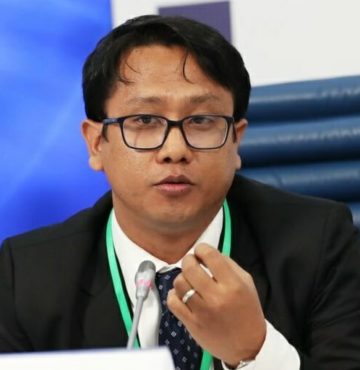By Monish Tourangbam and Arushi Singh
Lately, Pyongyang and Seoul have been engaged in a Cold War style bizarre “game of chicken”. If North Korea has been hitting its Southern neighbor with trash-filled balloons, carrying manure, cigarette butts and waste batteries, the latter has been blaring popular pop band BTS music through huge loudspeakers.

In South Korea, ruling and opposition parties have different views on this tit-for-tat tactic. The ruling People Power Party (PPP) supports the move as appropriate, and the opposition Democratic Party of Korea (DPK) berates such countermeasures as escalatory in nature. Recently, some South Korean troops also fired warning gunshots to repel North Korean soldiers crossing the border although the incursions were reported to be unintentional.
Vladimir Putin’s visit to Pyongyang has caught the global limelight, with the Russian President and North Korea’s leader Kim Jong Un, signing a mutual defence accord, agreeing to come to each other’s support to deal with an aggression and Kim supporting Russia’s invasion of Ukraine. In Washington, President Biden had earlier expressed his ire to Pyongyang over the planned Russian President’s visit.

On June 5, the U.S. reportedly flew a long-range B-1B bomber over the Korean Peninsula, as part of its first precision-guided bombing drill with South Korea in seven years, in a show of Washington’s deterrence commitments to Seoul. A few days later on June 10, the U.S. and South Korean leaders also met for the third meeting of the Nuclear Consultative Group, discussing, among other things, enhanced nuclear deterrence in the Peninsula. Recently, Japan also joined the U.S. and South Korea in strongly opposing Pyongyang’s latest ballistic missile launches conducted at the end of May and committing to policy alignments on handling North Korea, particularly, denuclearization and stability on the Korean Peninsula.
This follows Seoul’s 3050 Strategy initiative announced by the country’s Ministry of Trade, Industry, and Energy aimed to decrease the country’s dependence on China to less than 50% by 2030 and to stabilize South Korea’s supply chains. The US likewise aims to restrict China’s access to semiconductor technology while encouraging South Korea and Japan to do the same.
However, Japanese and South Korean leaders also met with Chinese Premier Li Qiang to restart trade and security dialogues, including the implementation of a free trade agreement plus a host of other non-military matters like health and climate change, with Qiang advocating ending protectionism and decoupling of supply chains. On May 26, before the commencement of the trilateral meeting, South Korea and China conducted a bilateral meeting wherein multiple initiatives were discussed focused on security and economics. They included “Korea-China 2+2 Diplomatic and Security Dialogue;” the restoration of official channels of communication and entry into the second phase of the Korea-China Free Trade Agreement. This also illustrates Beijing’s desire to move away from hostilities that lingered in the aftermath of South Korea’s deployment of THAAD systems in 2016 and the resultant unofficial sanctions. China has long been opposed to the deployment of the system to South Korea. Beijing contends that the radar used in the battery could degrade its nuclear second-strike capability against the U.S.
China’s Foreign Minister Wang Yi also met with South Korea’s Foreign Minister Cho Tae-yul on May 13 in Beijing. This meeting occurred more than six years after a South Korean Foreign Minister last visited the Chinese capital. During the meeting, Wang Yi reportedly stressed that “external interference should be eliminated” and encouraged the advancement of bilateral efforts. China has also been reliant on Japan for increasing its foreign direct investment (FDI) by enhancing its “charm diplomacy.” Beijing has been striving to limit its provocative behavior and enhance its diplomatic initiatives to counteract U.S. initiated groupings and manage regional tensions.
Significantly, Japan has been making overtures to North Korea, including the prospect of a summit between Japanese Prime Minister Fumio Kishida and North Korean leader Kim Jong Un. Additionally, Japan proposed establishing contact via email, but Pyongyang rejected the proposal without Tokyo altering its policy position. South Korea’s leader, President Yoon, outlined an “audacious initiative” that entailed the implementation of a large-scale food program, power infrastructure development assistance as well as modernization of travel infrastructure. The initiative also aimed to boost North Korea’s agriculture output, upgrade its medical facilities, and offer Pyongyang financial support programs.
These developments, in part, show regional stakeholders exhibiting strategic flexibility to work on important issues through multiple forums with different countries to push national objectives despite ongoing differences, including those emanating from great power competition in the region. However, the regional parties are also cognizant of security red lines, the volatility of geopolitics and the limitations of cooperative behaviors. This is particularly significant, as the countries surrounding the Korean Peninsula have to contend with an anxiously assertive China. Beijing is likely to become increasingly aggravated amid rising economic and energy challenges as well as a proliferating distrust of its regional and global influence. China is likewise slated to be concerned about its perceived decline, which has been illustrated by the Middle Income Trap wherein the country is projected to become old before it can become rich. This is likely to manifest in regional tensions as Beijing aims to hold on to its regional dominance while tackling increasingly complex domestic challenges and global apprehensions.
As such, the shape of things in the emerging geopolitics of the Korean Peninsula leave no space for permanent enemies as regional countries push for greater collaboration to overcome emerging challenges. These goals include the shared interest in building constructive ties with China. Tokyo’s national security strategy calls for a “constructive and stable” relationship with China while South Korea’s Indo-Pacific Strategy stresses the continuation of the trilateral meetings despite President Yoon’s positive inclination towards the U.S. Perhaps, Seoul and Tokyo want to enhance Beijing’s commitment to reining in North Korea’s nuclear ambitions and collaborations with Russia. China is similarly receptive to the overtures by Japan and South Korea as it aims to preempt the U.S. aims to limit its access to advanced technology and counter American-backed military alliances. This is despite Tokyo’s deployment of 400 US Tomahawk long-range cruise missiles; expansion of US-Japan-South Korea exercises; and maintenance of US warships in Japan. The China-Japan-South Korea trilateral meeting further highlighted the fact that the “US [regional] allies have their own interests to manage” which extend beyond Washington’s priorities in the Korean Peninsula and are aimed at managing and shaping the politics, economics and security which are more local, and endemic to the region.
Monish Tourangbam is Director at the Kalinga Institute of Indo-Pacific Studies (KIIPS), India
Arushi Singh is a Geopolitical Risk Analyst with a private consulting firm based in the Middle East.







